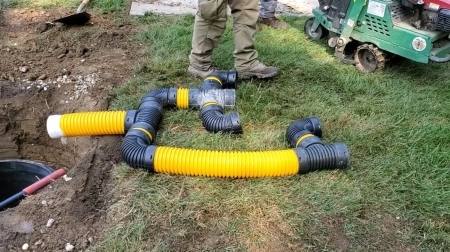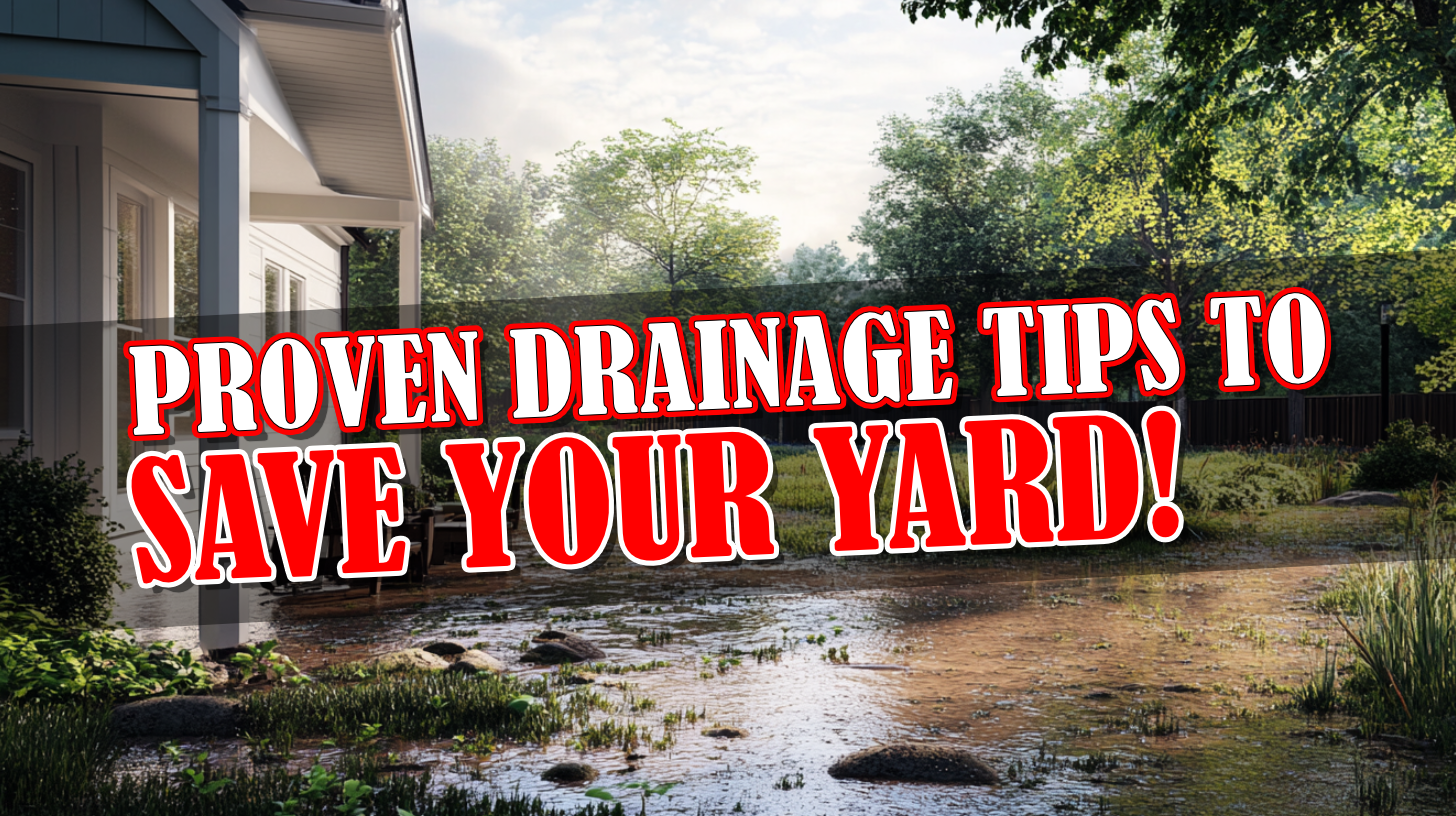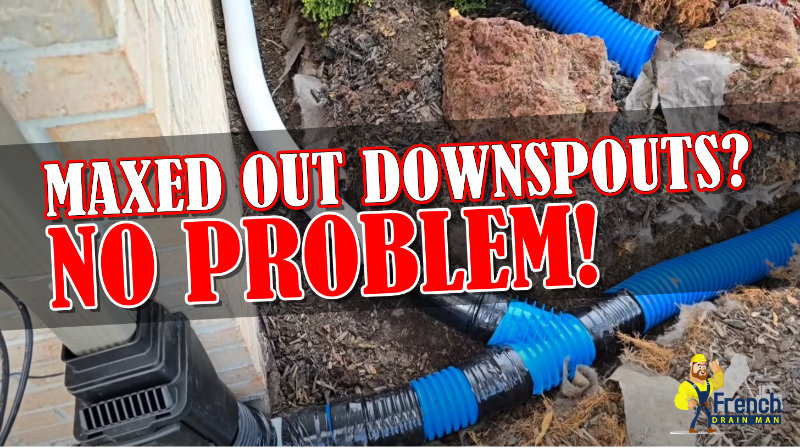How To Build a Leach Filed for Yard Drainage Systems – Episode 3/5

These are contractor rolls. We sell these in yard only. There are six knife cuts in the Baughman. This is Baughman virgin yellow. It’s yellow on the outside, it’s yellow on the inside. This stuff is going to last for 200 years to 500 years is the projected estimate on this material.
Now because it’s virgin material and it’s not made out of recycled restaurant containers, you don’t have raccoons and skunks digging it up and chewing on it. Because we’ve seen it, we’ve experienced it. And that’s what happens when you use that recycled stuff. So we like to use Premium Baughman gold, that yellow. Look for it in your knife. Cut your eight-slot. You know the Baughman High Octane is virgin material too in the royal blue.
All this stone. This is a septic fieldstone. It’s washed. It’s a half-inch to three-quarter. Nice round rock. Round rock creates more voids and it doesn’t get compacted like crushed stone. We’ve gone over this, but it’s always good to have a reminder.
So let’s get in the back and keep up with the guys because this thing goes quick. When you know what you’re doing and you’re working with a bunch of guys for a number of years, everything flows so smooth and goes so in sequence, it’s unbelievable.
Rock and roll, man. Here we go. So this is our 18-inch bucket. Then we switched to our 14., I’ll get to all the details. All right, so this is going to be three lines of Baughman Knife-cut. Guys, guys, guys, when your trenches are filling up with water, leave a dam, skip a section of the clay or heavy soil and don’t work in the mud unless you like to. I mean you’re your prerogative.
All right, so we got a 24 by 24 blind inlet there. Look at this man. Look at how nice that opened French drain is.
So when the flash floods happen and all that water is coming out of that cul de sac and is just pouring down the steep grade, and I mean it’s just insane. So we got a curtain drain that starts right there and it’s covered until this point. And then we’re grabbing up bulk water with an open French drain and then it continues and it ties into that blind inlet along with this.
So we got grass cover in here and then we go to an open, I mean water, it’ll go through that stone so fast. It’s nearly uninterrupted. I just, it’s amazing.
We have our non-woven geotextile fabric. We went with our four-ounce because it moves water faster than the eight and we have it put through the process twice with all the holes punched in it and it has the highest flow rating and flows more water than any other fabric period. And it still has a hundred pounds of tensile strength. So good stuff. Good stuff.
Now, this is looking good. This is looking really good. I mean, it sounds crazy, but we get excited when we build systems and we just can’t wait for like the next big, you know, rain to come through so that the customer can, you know, report back to us and just tell us… What an improvement it is as a homeowner to not have to stress and worry about water entering the house, destroying the home, destroying your belongings.
So we’re going to do triple pipes in here and I will get back to you.
How did we get to that point? If you haven’t seen episode one and episode two I encourage you to do so. So you can pick up right from the beginning. This is a yard drain to leach field when it’s light rain, the storm sewers do actually work in the street, but during flooding conditions, the streets swell up with water. So we have to build a leach field.
We have an 18-inch bucket on the machine and we’re digging a really deep, really wide leach field down the side of the house and across the whole front of the yard.
Every soil type has some sort of perc. I know we talked about clay, how you can dig a hole the size of a five-gallon pail, fill it full of water and it just sits there for days. But we know that if that water sits there long enough, the clay starts to become, you know, soft. The ground’s no longer hard like concrete. So to my point, everything does leach water. It’s just, it takes, it takes certain soils longer. So, when you do a leach field, you’re spreading the water over a large distance and you’re creating a reservoir for it to stay until either, in this case, it’s taken in by the storm drain or it’s all completely taken in by the soil. So that’s what a leach field does.
When you do a sump pump discharge line and there’s no storm drain catch basin and you take it to a leach field depending on how active the sump pump discharge line is, how big your leach field needs to be.
So we’re removing a lot of heavy soil. We rolled in with all our dump trucks and dump trailers and we were hauling out so much heavy soil and bringing in so much stone for this job. This was a fun job for us. I know the homeowner was just at ease, you know, once we got done putting in this yard drain to leach field with the problems he’s been having, you could see it. I know that it’s been a long time coming for him.
This is the only way to handle these situations where you’re at the bottom of a hill. The water comes so fast and there’s so much of it If you can’t contain it in a large yard drain system, and this case start to disperse and lose some of that water in the front yard in a leach field, it’s gonna fall behind and the water’s gonna find its way into that walkout. This is a walkout, so you know there’s zero-tolerance when you have a walkout. You got to get all the water as soon as it comes in.
All right, buddy. Thanks for the ride. Appreciate it. Yeah.
Back to Rochester Hills, Michigan, where we’re taking a sump pump discharge line to a five-finger leach field.
The leach field is going to have Baughman Tiles knife cut. There are six knife cuts per valley. This is going to hold all the water and let it slowly dissipate into the soil. Now I realize that the soil doesn’t perc that well. We’ve got a clay pan. That’s why we’re spreading it over such a large distance. When a sun pump discharge line goes on, you have gallons, gallons of water and during a rain event you’ll have hundreds of gallons and you can’t ask the small area where it’s discharging it taken all that water.
So we have a vertical drywall 24-inch crock right there. We have a bunch of drainage stone around it and that drywall has half-inch and three-quarter-inch holes drilled. The water is going to slowly run into the gravel and into the subsoil. During really hard rain events, it’s going to end up in the five fingers in the leach field.
This was a big job, pretty decent size leach field for a yard drainage system. Our first sump pump discharge line in this case, but the guys were moving really, really swift. Again, it did take all hands on deck and I was trucking for Scott to make this possible.
We’re just about done with the well. The well is 48-inches deep. It’s going to have a lot of straw over top of it as well as dirt and that insulates it. We will just grow grass over it. It’ll be out of sight and you don’t need to access this for any reason whatsoever. This gentleman doesn’t have any buildup of minerals or iron ochre.
You’re one of the only ones in the country that do this thing?
Yeah, I’m actually leaving as soon as we’re froze out. We’re going to Georgia. So you’ve got a bunch of work lined up in Georgia for the winter. We get calls all over the US.
Your video, your website is amazing. And I thought, there’s no way I could do this, you know, going to try it. I said I’m too old for that. I’m 64 years old. There’s no way in hell than I can do any of this. I’m not an expert, you guys are.
You know we got a half a million dollars worth of equipment in the street that we’re working with too. I tell people, even if you want the rental store, you’d go broke. I mean, what I charge you, you’ll spend in rentals.
I had three or four landscapers for prices and none of them suggested to do it the way you did. I mean, I don’t want to spend $4,000 bucks on my back yard — bullshit. Right. But, I have this problem and I want it taken care of. right.
Well, when you wait to see what we’re going to put together here, you’re going to be very impressed. I don’t doubt it. I don’t doubt it. Yeah. It’s a, it’s a, you know, it’s a big fricking project. Yeah. Done right. Done. Right. You know, but these guys that come with a pickup and a bunch of catch basins, they, it’s unfortunate what they do. They take people’s money and you’ve seen the prices too for like catch basins and stuff and it’s not a solution that won’t work. You know, it’d be something if it would work, but it doesn’t work. Right. My dumpster, I have a three-yard dumpster in our yard. My dumpster is full of old systems. Literally just about every day they’re coming in with systems they tore out to put in our systems and our dumpsters are full of all these gimmicks and a bunch of the wrong pipes misused.
Yeah, yeah, yeah, yeah, exactly. Well, that’s why your website, I mean it really is because I tend to before I hire somebody tried to do my due diligence. And your website was wonderful.
Well you said your brother had some ideas and I’m like, look, you know what, actually that wasn’t my brother who wasn’t, who was another landscaper and it wouldn’t have worked. He was a landscaper. He wanted like about $2000 bucks and he was gonna take where it dumped and just go right back there, way back in the works.
I’ll tell you, you would have been so disappointed, there’d be so much water standing back there.
Yeah. And that’s what I told my wife and neither one of us are happy to spend that kind of dough on this. But it’s like, you know, I don’t want any trouble. I don’t want a hassle. I want it to work. I don’t mind spending a couple of thousand bucks more so it’s done.
Do you know where the, Oh, do you know where the overflow on your sump line goes? Because it’s buried. There’s an overflow on the sump right here. Is it? I’m not sure I knew. I just, okay. I got a little extra, a little pipe bone over here. Yeah. Is that what you’re talking about?
Yeah. It comes right off of your sump line. Off the house there.
Is that bad?
Well, if this ever froze up, but I’m going to cover it with straw to insulate it so it should withstand a lot. That’s called freeze protection so that if you froze up, it would dump just on the outside of the house, which if it if this freezes the grounds froze solid and just, it’ll just run away. But it’s buried underground. Somebody connected a pipe to it. So I’m concerned that that could freeze up and now you lost your freeze protection because it should be just, I’ll show you in a minute here.
We went four feet, four and a half feet. Big enough for five pipes and they will be tied together. You can measure five pipes.
How far are you going to take those pipes out? 50 feet. 50 feet. Okay, cool. That’s great.
The mosquito hatchery that you got going on over there. I mean, I know you’re running your sump running enough. Everyone’s is. Yes. And you’re right. Michigan’s water table is high right now and it’s expected to be high for the next four years.
Wow. No kidding.
So this was money well spent. Oh, good man. Nice work. Nice work.
Seems like a really heavy-duty container to that too. They’re nice. The ones that I’ve seen.
That’s, that’s culvert pipe.
Is it really?
Yeah. That’s for driveway culverts.
Like commercial grade stuff, right?
Yeah, you can drive semis over that.
Wow. Okay. I’m glad to hear that. Cause I,
I just wanted to mention that you always want to drill your vertical drywell first. And I’ll tell you why. If you start by cutting the sod off and just trenching out the leach field and then you go for your vertical drop, the auger is gonna keep, it’s almost like it’s thrown off balance when there are not the dirt 360 degrees all around it. So that’s something that we’ve learned. You want to definitely do your vertical drop. Go ahead, do your auger first and then go into your horizontals.
So we cut the sod off the top. You guys have seen this before. We cut the sod and we put it off to the side. Same rules apply, you know, set your sod cutter, whether it’s a rental or whether you’re a contractor and you own it. Set it for the deepest notch. Remove as much root and dirt as you possibly can get, and it will grow over this leach field just fine.
Unlike our French drains where we’re taking in water, all the surface water, this is different. We’re going to have a lot of soil covering these five fingers and this leach field. This grass is going to grow great. You’re not going to have to worry about that.
You can see the manifold is laying on the ground there. That’s going to go from the dry drywall, the vertical drywall to the five fingers that we’re gonna have across the back of this yard here.
Watch How to Build a Leach Field for Yard Drainage System Episode 1 – 5
- How to Build a Leach Field for Yard Drainage System – Episode 1/5
- How to Build a Leach Field for Yard Drainage System – Episode 2/5
- How to Build a Leach Field for Yard Drainage System – Episode 3/5
- How to Build a Leach Field for Yard Drainage System – Episode 4/5
- How to Build a Leach Field for Yard Drainage System – Episode 5/5








